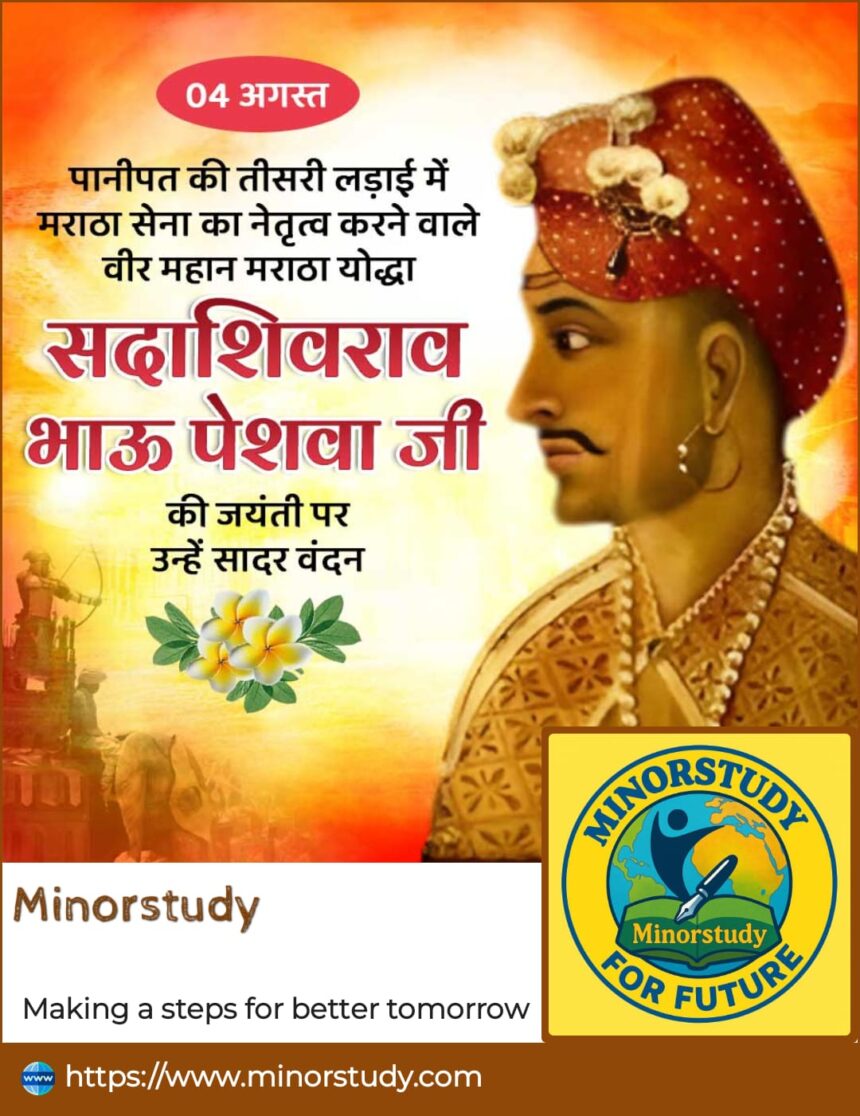7 Shocking Truths About Sadashivrao Bhau Peshwa Ji That Changed Indian History Forever!
Sadashivrao Bhau Peshwa Ji—one of the most valiant yet tragically misunderstood warriors in Indian history. Known as the Commander-in-Chief of the Maratha Empire during the Third Battle of Panipat, his legacy is both glorious and heartbreaking. His story echoes through time as a symbol of courage, ambition, patriotism—and lessons to learn from strategy and leadership.
- 📜 History of Sadashivrao Bhau Peshwa Ji
- 📌 Timeline of Key Events
- 💡 Key Facts About Sadashivrao Bhau Ji
- 🙏 Significance in Indian History
- ❓ Frequently Asked Questions (FAQs)
- 1. Who was Sadashivrao Bhau?
- 2. How did he die?
- 3. Was Sadashivrao Bhau responsible for the defeat at Panipat?
- 4. What was his biggest contribution to India?
- 5. Is there any memorial for him?
- 🌟 Wishing and Remembrance
- 🧠 Importance in Our Life and Society
- 🧭 Observance and Cultural Remembrance
- 🔑 Important Points Summary
- 🧘 Conclusion: Daily Life Impact and Reflection
- ✅ Final Thought
Let’s explore the history, significance, and lasting impact of Sadashivrao Bhau Ji, in a human-friendly, deeply researched narrative that brings his world back to life.
📜 History of Sadashivrao Bhau Peshwa Ji
Sadashivrao Bhau (born in 1730 – died on 14 January 1761) was the cousin of the legendary Peshwa Balaji Baji Rao (Nana Saheb). As the son of Chimaji Appa (brother of Peshwa Bajirao I), he was raised in a family that represented power, valor, and political intelligence.
From a young age, Sadashivrao was trained in statecraft, warfare, and administration. He later became the Finance Minister (Amatya) and eventually the Commander-in-Chief of the Maratha forces.
🔥 Military Career and Major Battles
Conquest of Karnataka (1747–1752): He played a key role in consolidating Maratha influence in the South.
Battle of Udgir (1760): Led the Maratha army to a significant victory against the Nizam of Hyderabad.
Third Battle of Panipat (1761): His most remembered and tragic campaign. He led a massive Maratha army northward to stop Ahmad Shah Abdali’s invasion, which ended in a massive bloodbath.
📌 Timeline of Key Events
| Year | Event Description |
|---|---|
| 1730 | Birth of Sadashivrao Bhau in Saswad, Pune. |
| 1740s | Actively involved in Maratha southern campaigns. |
| 1752 | Married Parvati Bai; took on bigger administrative roles. |
| 1759 | Appointed Commander-in-Chief by Peshwa Nana Saheb. |
| 1760 | Won the Battle of Udgir. |
| 1761 | Died in the Third Battle of Panipat on 14 January. |
💡 Key Facts About Sadashivrao Bhau Ji
Architect of Southern Consolidation: His victories in the south laid a strong foundation for the Maratha Empire.
Progressive Leader: He believed in modernization and disciplined warfare, even introduced European-style artillery corps.
Family-Oriented: He took his wife Parvati Bai to the Panipat campaign—unusual for a wartime march.
Diplomatic Mind: Tried negotiating with Afghan leaders before the war but failed due to timing and misunderstanding.
Courageous to the End: Fought till his last breath in the battlefield, refusing to retreat.
Economic Administrator: As Finance Minister, he helped stabilize the Maratha economy.
Remembered with Reverence: Despite the Panipat loss, he’s remembered as a true patriot who gave everything for Bharat.
🙏 Significance in Indian History
The Third Battle of Panipat (1761), where Sadashivrao Bhau died, was a turning point in Indian history. Though the Marathas lost, the battle showed:
The potential of Indian unity: Various forces rallied behind Bhau Ji.
The tragedy of missed alliances: Rajputs and Jats abstained, which proved costly.
The brutality of foreign invaders: Abdali’s army killed over 100,000 people.
The heroism of Indian resistance: Despite exhaustion, the Marathas fought valiantly under Bhau Ji’s leadership.
Had this battle been won, India might have experienced a vastly different political future—one not dominated by British colonialism.
❓ Frequently Asked Questions (FAQs)
1. Who was Sadashivrao Bhau?
Sadashivrao Bhau was a Maratha leader, Finance Minister, and later the Commander-in-Chief of the Maratha army, best known for leading the Maratha side in the Third Battle of Panipat.
2. How did he die?
He died fighting in the Third Battle of Panipat on 14 January 1761. His body was never found, giving rise to many theories and folk tales.
3. Was Sadashivrao Bhau responsible for the defeat at Panipat?
While he was the commander, many historians agree the defeat was due to poor alliances, long supply lines, and the absence of crucial support, not his sole decisions.
4. What was his biggest contribution to India?
Apart from military leadership, he helped stabilize the Maratha economy and promoted a modern army structure with trained artillery units.
5. Is there any memorial for him?
Yes, the Panipat battlefield has a memorial, and he is remembered in many Maratha ballads and folk songs.
🌟 Wishing and Remembrance
“💐 Shraddhanjali to the brave Sadashivrao Bhau Ji — a lionheart who gave his life for Bharat. May his courage inspire generations to come. 🙏”
If you wish to honor him:
Light a diya on January 14 (the date of his martyrdom).
Visit local libraries or museums to read more about Panipat and the Marathas.
Share his story with the younger generation.
🧠 Importance in Our Life and Society
💬 Leadership Lessons:
Sadashivrao Bhau’s life teaches us about:
Courage under fire
Planning with empathy
Standing firm in the face of adversity
👨👩👧👦 Societal Impact:
He represents a class of native leaders who tried to defend Indian sovereignty without foreign help.
Reminds us of the importance of unity, especially when facing external threats.
📚 In Education:
His life is a valuable part of history curricula in Maharashtra and other parts of India.
🧭 Observance and Cultural Remembrance
Annual Remembrance Day: January 14, often in Panipat or Pune.
Documentaries and Books: Numerous Marathi and Hindi publications revisit his life.
Folk Culture: Marathi Lavani and Powada songs keep his name alive in oral tradition.
🔑 Important Points Summary
Sadashivrao Bhau was a brave Maratha warrior and administrator.
Known for modernizing the Maratha army.
Fought and died in the decisive Third Battle of Panipat.
Left behind a legacy of sacrifice, patriotism, and strategic depth.
Revered as a martyr across Maharashtra and northern India.
🧘 Conclusion: Daily Life Impact and Reflection
Sadashivrao Bhau’s story isn’t just history—it’s a lesson in perseverance, national pride, and the cost of disunity.
In our daily lives:
He teaches us to stand firm even when outcomes are uncertain.
He reminds us that leadership is not about fame, but sacrifice.
He inspires us to prepare wisely, adapt quickly, and never give up.
In a world driven by personal gain, his life teaches us to think beyond ourselves and act for the collective good of society and country.
✅ Final Thought
“History is not just a list of names and dates—it’s a mirror. And when we look into the life of Sadashivrao Bhau, we see not just a warrior, but a reflection of our own potential for bravery, leadership, and legacy.”








